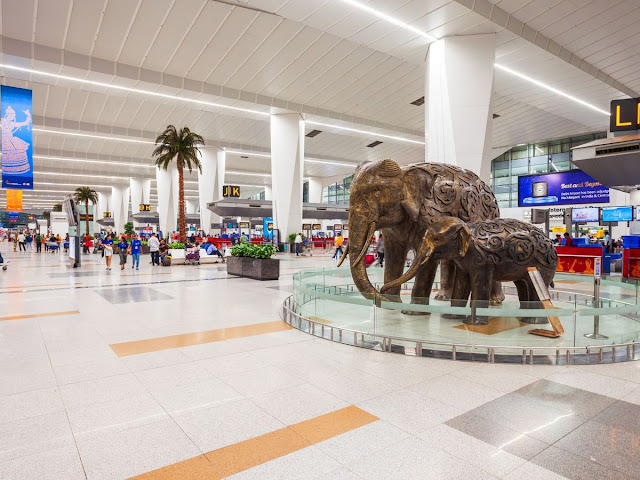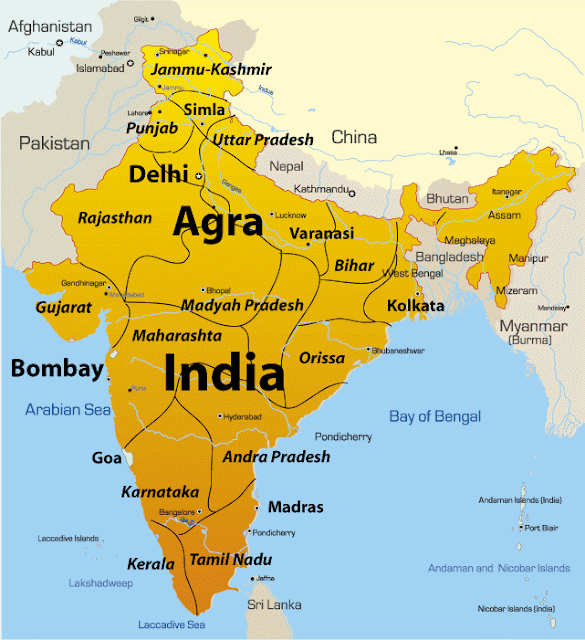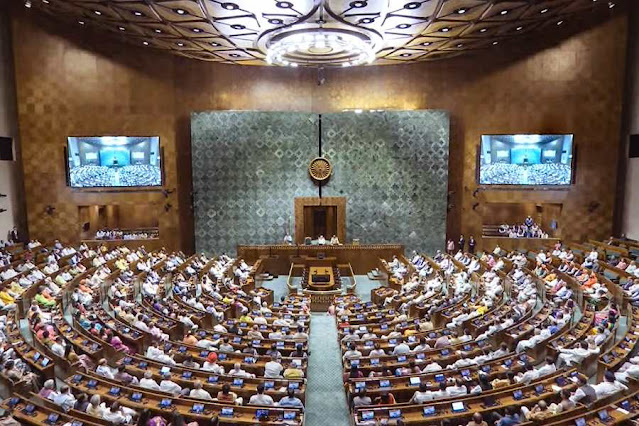Lewis and I decided to travel halfway around the world. We joined a travel group going through the "Golden Triangle" on the Indian subcontinent: the cities of Delhi, Jaipur, and Agra. Orchestrated by a global tour company called Gate1, it was the first time we ever booked a trip with a tour group. It was a blast! This is the Republic of India's flag.
The central emblem is a dharmachakra (wheel of dharma), which is used in Buddhism. The wheel was popularized by Emperor Ashoka the Great of the Maurya Empire of 268 BCE, who erected pillars across India with inscriptions of his edicts to solve social issues with Buddhist teachings.
The surviving pillars are treasured parts of Indian architecture.
Incidentally, India is the nation where Indians reside: not North America. The fact that "educated" Americans still refer to the Native Americans as "Indians" demonstrates their dull-witted lack of awareness. It is atrocious because such uncaring mislabeling is based on a 1500s-era misconception that the locals were like people in India, due to the color of their skin. The game "Cowboys & Indians" is as false as the claim that the tribes were the enemy. Now that we're accurate about who Indians are, let's continue!
Interestingly, the day before our journey, I popped into my local coffeeshop. While awaiting my espresso, I had the urge to look up. Surprisingly, a recently-added statue of Ganesha was on a shelf overhead! Perhaps, the Indian deity (a remover of obstacles) sent good vibes to me for our trip. I was grateful for the coincidental experience.
We flew aboard Air India, which conveniently allowed us to keep our shoes on during pre-boarding security checks. (Only the airlines in America create that dirty inconvenience—and stupidly never disinfect the X-ray trays after people's shoes are put in them).
North of the Arabian Sea and the Indian Ocean, we landed in the capital city of Delhi. It is located on the enormous Indo-Gangetic Plain, which has been a fertile area for millennia. The capital is near the Kashmir region, known for the export of cashmere wool. Opened in 1962, Indira Gandhi International Airport remains the most advanced (and busiest) one in India.
It outclass NYC's neglected JFK Airport from the same era! We admired the sleek facility—soon to be refurbished again (before NYC's starts its first "promised" remake).
Immediately, my T-mobile plan gained cellular access.
To avoid confusion, I will explain that Delhi is the national capital, and it has two parts. Old Delhi refers to the historic Old City district. It was founded in the 1200s. In 1639, the Mughal emperor, Shah Jahan, moved there from Agra and established it as the new capital. In 1803, the British East India Company's troops won the Battle of Delhi to subjugate India. (They were probably desperate to regain land after losing the American Revolution. In 1757, the Company conquered the Sultanate of Bengal—now Bangladesh. In 1885, the British conquered the neighboring Kingdom of Burma—now named Myanmar, a Buddhist nation). After England's domination of India, King George V—the Emperor of India—arrived and initiated New Delhi in 1911, as the new governmental center.
Geographically, Delhi is equal distance between Pakistan, the Buddhist nation of Nepal, and the mostly-Buddhist nation of Tibet. Once part of India, Pakistan was created by the British in 1947 with sovereignty and given a Muslim majority. India was given a Hindu majority. Currently, India, Pakistan, and Bangladesh belong to the Commonwealth of Nations.
India is the birthplace of Buddhism, and Delhi has fame in the epic Chinese fable about a Buddhist monk and his immortal bodyguards. It is titled Journey to the West, and it was written in the 1500s. Modern films and miniseries are still made about it. According to the travelogue, their pilgrimage passed through the city, as well as Agra.
*To see when Lewis and I visited the starting point of their trek in Xi'an, China, please use this link (it's an amazing city):
The travel coordinators at Gate1 sent an "airport aide" and a driver in an electric-powered shuttle bus to bring us to the hotel.
We rode to our first hotel, The Park, on Parliament Street in the diplomatic circle. The street is named for the Indian Parliament (Sansad Bhavan), farther down. It looks like this...
As a 5-star hotel in the heart of the capital, The Park nestles you into a welcoming vibe.
Spiffy security guards admitted us through tall iron gates.
Seeing professional security was a nice change from the typical guards seen in America... often eating and napping.
Whenever entering the hotel, luggage and guests pass through a metal detector. Done unobtrusively, it made you feel secure. Oddly, America's threat-crazed society doesn't do that.
Our room card was needed to move the elevators from the Lobby level. However, from our floor, we could move between floors, gym, spa, pool, or roof deck without it.
People greet each other in India with serene respect.
"Namaste" is the salutation and valediction of India and has been since ancient times. It simultaneously expresses honor, courtesy, hospitality, and gratitude to the other person. It says, "My soul recognizes your soul. I respect the love, light, beauty, truth, and kindness within you because it is also within me. In sharing these things, there is neither distance nor difference between us. We are the same." Along those lines, regardless of the old regime's caste system, everyone is treated equally in temples.
Our tour director, Jimmy (he preferred we called him that, rather than his longer Indian name), greeted us. Discreetly, he confirmed that one king-size bed was enough for us. We told him that we were a gay couple. He smiled cheerily and was glad that the accommodations were satisfactory.
"Namaste" is the salutation and valediction of India and has been since ancient times. It simultaneously expresses honor, courtesy, hospitality, and gratitude to the other person. It says, "My soul recognizes your soul. I respect the love, light, beauty, truth, and kindness within you because it is also within me. In sharing these things, there is neither distance nor difference between us. We are the same." Along those lines, regardless of the old regime's caste system, everyone is treated equally in temples.
For nice effect, the hallways had scent burners of melted wax, diffusing lovely floral aromas.
Since Lewis and I opted for all the extra excursions, most of the trip's meals were included in our booking. Three were not, including that night's dinner. After freshening up, we ventured a few blocks from the hotel for small plates of lentils, fresh naan, spicy chicken, piquant lamb kebabs, and Lewis' first taste of mutton.

Working in favor of American tourists, the currency exchange rate indicates how affordable things are. $295 rupees (as seen below for a dessert) = $4.03 U.S. dollars.
Above, notice above how that farm-to-table restaurant lists its sources for ingredients. After a hearty meal, we slept soundly.
The next morning, we started in the gym, which gave a lovely view of the parkland around the "official diplomatic neighborhood" that our hotel was in.
We savored a superbly-presented breakfast. The informal dining room opens at 7am, but I arrived at 6:40 (still adjusting to the 9-hour time difference).
The doors were open, so I strode in. Being twenty minutes early, I expected the staff to grumble about seeing me—as so often happens in Manhattan. But, they merely welcomed me warmly, invited me to start eating what was already put out, and continued to finish their set-up at a cheery pace. It was wonderful! Everyone smiled at me, put their hands together, and said, Namaste.
Throughout the Republic of India, there is a respectful shortage of beef and pork, due to religious reasons. Instead, expect soupy recipes, simmered vegetables, great tea, pan-fried cottage cheese, mutton and goat, small portions of intense sweets, and spices galore. It was delicious.
Jimmy gathered everyone into the lobby for our morning meeting. It was the first time that we laid eyes on our entire group of 17 other people. Two long-time friends were from the continent of Australia. The nation is a constitutional monarchy. The Queen of Australia is an Englishwoman named Elizabeth II. The island-nation is also part of the Commonwealth. Other travelers included three Japanese siblings living in New York, a Vietnamese woman living in New York with her Brazilian beau, a married couple from California, two retired Brooklynites transplanted to Florida, two sisters from New Jersey, two Filipino sisters, and a pair of fashionable Nigerians. Nigeria is part of the Commonwealth, which is headed by Queen Elizabeth II.
After our orientation meeting, we wore name tags around our necks and met our bus driver and bus attendant for the entire 7 day journey. Each morning, our easy-to-spot orange Mercedes-Benz coach bus was cleaned and dusted.
Our driver skillfully careened around cyclists and cows, and he dodged dogs and delivery vans. Every time we returned to the bus, the attendant squirted Purell into our outstretched palms. (Without that word Purell, that sentence might seem funny). Throughout the day, the attendant distributed chilled bottles of water, fruit, shoe covers for entering temples, and earphone headsets for Jimmy's walking tours (that's him below).
Noticing the attendant's spray-can of air freshener, I giggled and wondered what kind of group excursion we were going to have! "Wild Romance" indeed!
The street signs also welcome you with a "Namaste" emblem!
Like many places, seeing poverty around the city is unavoidable. Above, citizens relax in their environment—making the best of it. Below is a public watering facility.
Jimmy guided us to our first stop: the walled city of Old Dehli and the largest (and best-known) mosque in India, called Jama Masjid. Both were built by Mughal Emperor Shah Jahan in 1644 (who famously built the Taj Mahal in 1632). Seen below, the gatehouse faces the ancient city-wall.
To enter, women must cover themselves.
Men wearing shorts must wrap a cloth around their legs, so I did. My cloth had colors that matched my shirt.
As seen above, everyone had to remove their shoes and either wear "guest sandals" or enter barefoot. In India, it is customary to remove shoes when entering a "house of worship": mosque, temple, or church. Most Indians rinsed their feet and entered barefoot. We used sandals.
The mosque accommodates 25,000 worshipers.


The minarets are gorgeous! (Similar to church bells, they are used to give audio signals in every direction when it is time to pray).
Due to India's religions, art is prohibited from depicting living things. To exercise their vitality, artists and craftsmen use geometric patterns—in glorious ways. Below is a picture of the underside of an entrance archway. Notice the details! Like rays of sun, look how the bricks and white marble inlays form the "fan-shape". Then, see how the white marble is cut/formed to fit within the SCALLOPED ripples beside it!



After we unrobed, we went for bicycle-rickshaw rides through the bustling streets! The chaos was part of the adventure.
Even China has more controlled traffic rules! Such an adventure! All types of two and three-wheeled rickshaws, mopeds, bicycles, pushcarts, horse-carts, jaywalkers, and mini trucks putter and clutter through the narrow winding roads.

The man pedaling our rickshaw routinely stopped to holler at people ahead—or those who wouldn't pull over to make room for him to pass. Each time, he pumped his legs harder to regain momentum. I assume that his calves look amazing (like the running rickshaw men we saw in Japan).

Vehicles closely pass each other—on both sides! They still follow British methods of driving on the left lanes. (That made our rickshaw experience more startling: seeing oncoming traffic in the opposite lane). Similar to Japan, the steering wheels are on the right side, too.
From there, we settled into the quiet upscale boulevards where Mahatma Gandhi spent his last years. His final residence is on a street named for the spiritual Sri Aurobindo ashram nearby. Taken in by rich patrons, Gandhi occupied an austere bedroom in their otherwise lush estate. A condition of him accepting their offer was that anyone who wanted to visit him would be allowed. Thus, part of the lawn and gardens were reserved for Gandhi to greet people and inspire them.
Gandhi is also venerated with his visage on India's currency. Here is his image on a 50-rupee banknote.
Our tour group perused the onsite museum, admiring how Gandhi's repulsion at British imperial discrimination spurred him to calmly resist it... and British violence. It worked better than a thousand political machinations or revolts.

It's probably what Americans should do against their banks and bureaucracy.
In the onsite gift shop, Lewis purchased a hand-spun cotton sari, in maroon color. He looks quite dashing in it!

It's probably what Americans should do against their banks and bureaucracy.
In the onsite gift shop, Lewis purchased a hand-spun cotton sari, in maroon color. He looks quite dashing in it!
In a light-hearted mood, we segued to a Sikh temple named Gurudwara Bangla Sahib. To enter, everyone covered their heads with special handkerchiefs (similar to a Jewish yamaka) and removed their shoes to proceed barefoot. Once again, a faux steam allowed people to rinse their feet before entering... and another place lets people clean them when they leave. Jimmy explained that people remove their shoes before entering their homes. It is sanitary and respectful. The Americans in our group were scornful... unaware they have a bad reputation around the world.
The temple was magnificent.
Some people respectfully bathe to be clean before entering. Most people promenade around the pool's courtyard.


Photography is not allowed inside, but our companions snapped a few pictures (and shared them with us) of the Soup Kitchen, which feeds thousands daily: naan, rice, stew, and steamed vegetables. Volunteers peel vegetables, stir the cauldrons, bake bread, and portion the food onto plates. Visitors sit modestly on the floor of a large hall and have their meal in communal style.
It was past lunchtime when we ate at a Bollywood-themed restaurant (sorry, no floorshow). We enjoyed our group meals as much as when we broke into smaller circles. It encouraged us to get to know one another... just like Jimmy's rule of assigned bus seating (by couple), which changed daily.

To end our busy day, we visited the tomb of a Mughal emperor named Humayun. It was built in 1569, and it's a UNESCO World Heritage Site. It uses India's native Red Sandstone on a grand scale. As the first garden tomb in India's subcontinent, it inspired the Taj Mahal's architecture.

To end our busy day, we visited the tomb of a Mughal emperor named Humayun. It was built in 1569, and it's a UNESCO World Heritage Site. It uses India's native Red Sandstone on a grand scale. As the first garden tomb in India's subcontinent, it inspired the Taj Mahal's architecture.

A splendid water feature is the quadrilateral layout of rills. Like they do at Chinese palaces, the circulating water offers good feng shui.


The harmonious masonry and stonework details are breathtaking. Below, the vista includes nearby tombs. We noticed that India's historical sites attract many young people... some want to canoodle.

Since India guarantees employment, some accept positions restoring such places.

Restorers have quite a ways to go on the massive buildings.

Also on the site is the tomb of Isa Khan Niyazi, who died at the age of 95 in 1548.


Here's a fascinating fact: the founder of the Mughal Empire, Babur, was a descendant of Genghis Khan... and was bisexual.
Before we boarded our bus, a herd of goats passed between us, with a shepherd sashaying behind them!


Dinnertime occurred in the hotel restaurant, named Fire.





Dinnertime occurred in the hotel restaurant, named Fire.



We ate a splendid meal, accompanied by a native-grown Sauvignon Blanc. To say "Cheers" in Punjab is Śubhakāmanāvāṁ, which means "Good health". (There is not a way to say "Cheers" in Hindi because the culture doesn't celebrate by drinking alcohol, but they might clink glasses).
We noticed that when Indians use utensils, they smartly keep the fork in the left hand and the knife in the right. We do that, too, but most Americans obstinately retain the inconvenient method of shifting the fork between the left and right hands. America might be the only country that still does that.
After dessert, we returned to our room. Watching television, we learned that India gives free healthcare to it citizens!

India also offers free education to all children! Not yet compulsory, some poorer parents don't send their children because they'd rather have the children beg for money or work in shops.

Bringing reform to the educational sector, the government launched a Happiness Curriculum in state-run schools. It includes a 45-minute happiness session about morals and love, and 5 minutes of meditation before each class. That's true mindfulness in today's "gadget / wireless social media" world.
Many TV channels are dedicated to education: lectures, math, languages, or hands-on skills. By watching the programs and taking notes, you'd learn the topics.


The government also guarantees periods of employment.

India only collects 4% of its income tax, yet it manages to support such far-reaching national programs. Certainly, other taxes boost the government's revenue, but it puts America to shame when you realize how little the USA provides compared to how much revenue it squanders.
Lewis and I were ready for bed.

Tomorrow would be another adventure.




























.JPG)

.jpg)




























.jpg)

























.JPG)































No comments:
Post a Comment
Don't be shy: leave your comments :)